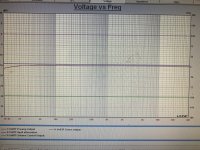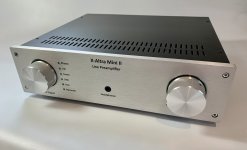"... The lsk389 is suited for lower impedance sources whereas the 489 is better suited for higher impedance sources such as MM phono"
That makes perfect sense and brings clarity as to the purpose of the part.
That makes perfect sense and brings clarity as to the purpose of the part.
Carl or anyone else that is interested, If you have the time read the lsk489 application note that Bob wrote, you can get it from Bob’s web site Cordellaudio.com or linear integrated systems
He explains the use of these parts and where they are best suited
He explains the use of these parts and where they are best suited
I used the 389 in the X-Altra MC/MM phononstage for the MM part and got stirling distortion and RIAA conformance results. Since the drain was configured inside the composite amplifier loop, the voltage changes at the drain are very small somewhat minimising the effect of the input capacitance. The RIAA all-active feedback also helps here since it’s sloping at ~-20 dB per decade from LF. This of course would not be the case in a passive pre where you typically have common source gain stage driving the EQ network.
The 20 kHz audio BW is small in the big scheme of things and not that demanding in the small signal regime. I guess if you were trying to build a very wide BW amp (100’s of kHz and up) the 389 would not cut it.
The 20 kHz audio BW is small in the big scheme of things and not that demanding in the small signal regime. I guess if you were trying to build a very wide BW amp (100’s of kHz and up) the 389 would not cut it.
Quick update on the X-Altra Mini II.
The MC/MM phono amp is tested and working very well with tight RIAA EQ as measured on the QA401. Its also very quiet - the MC only stage is under 400 pV/rt Hz (sim).
In general, I still have some work to do on the overall noise. I have mains harmonic peaks on the line inputs fitted with -15 dB attenuators at around -115 dBV giving a measured S/N of -103 to -106 dB (20 kHz BW). On the non attenuated inputs, the mains harmonics are at -130 dBV giving better than -110 dB . I’m shooting for all mains harmonics peaks to be better than -125 dBV at any volume control setting and on any line input.
On line level inputs, the thermal spot noise is -140 dBV with the volume control set to 0 and the same at max with the selected input shorted.
I‘m away until the end of the month, but will pick things up again in May, when hopefully I can crack the problem.
The MC/MM phono amp is tested and working very well with tight RIAA EQ as measured on the QA401. Its also very quiet - the MC only stage is under 400 pV/rt Hz (sim).
In general, I still have some work to do on the overall noise. I have mains harmonic peaks on the line inputs fitted with -15 dB attenuators at around -115 dBV giving a measured S/N of -103 to -106 dB (20 kHz BW). On the non attenuated inputs, the mains harmonics are at -130 dBV giving better than -110 dB . I’m shooting for all mains harmonics peaks to be better than -125 dBV at any volume control setting and on any line input.
On line level inputs, the thermal spot noise is -140 dBV with the volume control set to 0 and the same at max with the selected input shorted.
I‘m away until the end of the month, but will pick things up again in May, when hopefully I can crack the problem.
Last edited:
Hi Andrew,
A like your design. It’s very well thought out with design that works with readily available parts. I agree on your choice of pot value and placement of the gain stage as early in the signal path as possible.
Attached is a simple simulation of the gain structure.
The top purple line is the source input which we can refer to as 0 db.
The blue curve is the output of the fixed input pad on the cd input. The attenuation is - 14.3 db.
The green curve is the output level of the Log 20k pot at 50% rotation and attenuates the input signal overall by - 29.8 db. The resistance is about 9k at 50% rotation.
The blue curve is the discrete line output level -14.7 db at 50% rotation of the volume pot.
ln the case of the un attenuated inputs at a nominal 300mv the discrete line output is of course 15db above the source input level. The level is about 1.7 volts ref an input of 300mv. Perfect for driving a power amp with an input sensitivity of 1.7 volts .
Excellent.
A like your design. It’s very well thought out with design that works with readily available parts. I agree on your choice of pot value and placement of the gain stage as early in the signal path as possible.
Attached is a simple simulation of the gain structure.
The top purple line is the source input which we can refer to as 0 db.
The blue curve is the output of the fixed input pad on the cd input. The attenuation is - 14.3 db.
The green curve is the output level of the Log 20k pot at 50% rotation and attenuates the input signal overall by - 29.8 db. The resistance is about 9k at 50% rotation.
The blue curve is the discrete line output level -14.7 db at 50% rotation of the volume pot.
ln the case of the un attenuated inputs at a nominal 300mv the discrete line output is of course 15db above the source input level. The level is about 1.7 volts ref an input of 300mv. Perfect for driving a power amp with an input sensitivity of 1.7 volts .
Excellent.
Attachments
Last edited:
Rear panel is made from two stacked PCB’s. No drilling or filing. 😊👍

Will it be possible to purchase the different PCBs separately? It would be of interest to build only the discrete JFET line amp as a companion for my KX2.

Making the back panel out of circuit boards is cool, they print all the art work for you. I have been meaning to get set up to silkscreen my front and back. This project is really cool because you can pick and choose for your configuration. By the way cool looking KX2.
Chris, You will be able to get whatever boards you want from the set. I guess a lot of folks will want to do their own thing with them - that will be fine with me 🙂
Nice looking housing BTW!
Nice looking housing BTW!
That is excellent, then an abbreviated version can be built and later expanded as required. Looking forward to start with the discrete line amp.
The KX2 housing is just built from recycled materials, of importance is sq and it sounds lovley. Thanks for excellent design and clear instructions. I trust the preamp will be of the same high class.
The KX2 housing is just built from recycled materials, of importance is sq and it sounds lovley. Thanks for excellent design and clear instructions. I trust the preamp will be of the same high class.
- Home
- Source & Line
- Analog Line Level
- X-Altra Line Level Preamp


